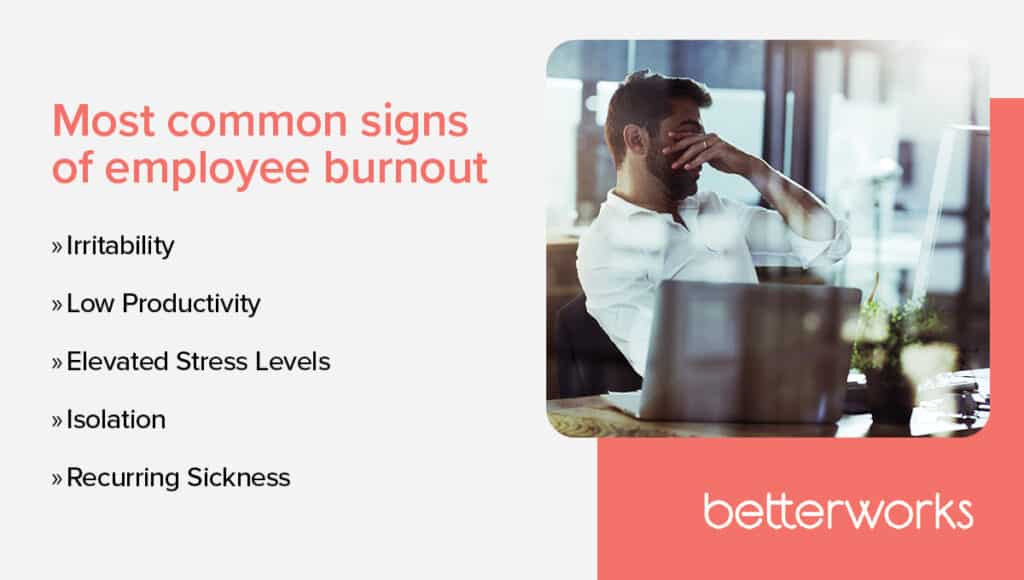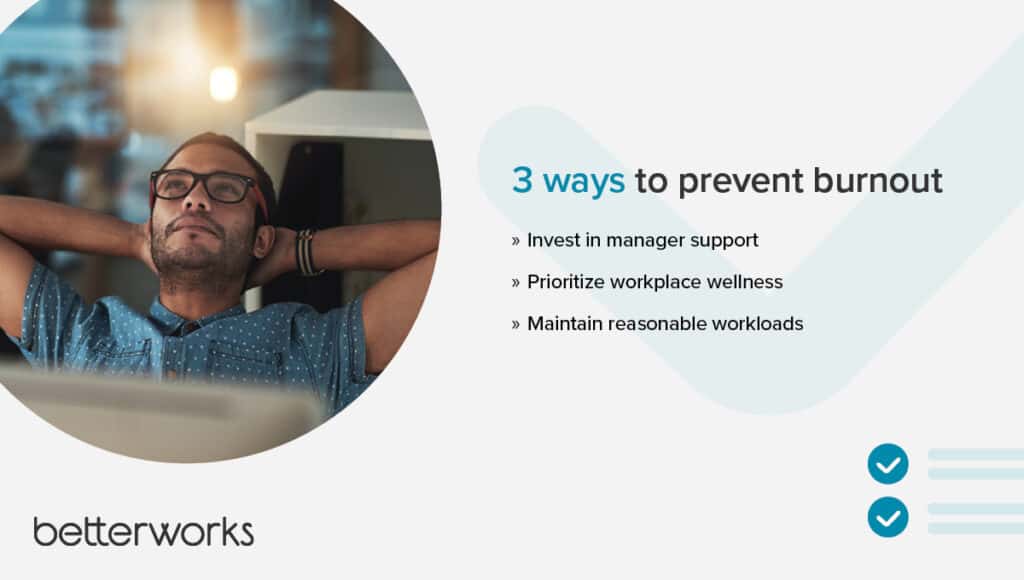It’s no secret that rapid changes in how we live and work have increased stress and burnout for many employees. Addressing this problem requires managers who quickly recognize the signs of employee burnout and HR leaders who can design systems to reduce the risks of it happening.
Seventy-two percent of employers say stress and/or burnout are concerns for their organization, according to MetLife’s 2022 U.S. Employee Benefit Trends Study. However, even as employers acknowledge this challenge, the study also found that they tended to overestimate their employees’ mental well-being — especially in smaller organizations.
Let’s learn more about burnout, how to reduce it in your organization, and how to help employees feel safe sharing how they’re doing in the workplace.
What is workplace burnout?
Workplace burnout is a specific type of job-related stress. The World Health Organization defines it as a syndrome “resulting from chronic workplace stress that has not been successfully managed.”
Three distinct factors characterize workplace burnout:
- Exhaustion or extreme fatigue
- Increased negativity, cynicism, or feeling removed from the work
- Reduced effectiveness
Workplace burnout has many potential contributing causes. Some relate to workplace dynamics, including unfair treatment, an unmanageable workload, and a lack of control over day-to-day assignments.
Other factors contributing to employee burnout include a lack of manager support, unclear communication, and unreasonable time pressures, Gallup research found. When employees strongly agree that they are often treated unfairly at work, they are 2.3 times more likely to experience a high level of burnout.
What are common signs of burnout?
Diagnosing burnout isn’t a straightforward exercise of comparing observations against a list of symptoms. Indicators of burnout can also point to other issues, or they could mean nothing more than a person having a bad day.
Signs of burnout don’t necessarily manifest in the same way, in the same order of progression, or at the same severity level in each person.
However, if you notice these five common signs of workplace burnout in someone’s behavior over a period of time, a bigger problem could be emerging.
Irritability
Personality clashes are inevitable in any environment that brings multiple working styles together. But if one of your employees can’t get along with anyone? Their irritability may be a sign of burnout.
Train managers to watch for unusual employee behavior, especially someone who gets upset or angry quickly. For example, if an employee who used to get along well with everyone now has acrimonious relationships with several colleagues, that may be a sign of trouble.
Irritability can also signal burnout when employees start complaining about work projects, colleagues, or even their own performance.
Low productivity
When an employee who was once very productive suddenly isn’t, burnout may be the culprit.
The problem is that burnout creates mental blocks to productivity, such as reduced attention span and problem-solving capabilities. Absentmindedness and a lack of motivation can also influence productivity, resulting in lower-quality work, missed deadlines, and an increase in minor mistakes. It’s a vicious cycle.
Elevated stress levels
Burnout is synonymous with high stress levels. However, employees present stress in unique ways. While an employee may seem perfectly composed on the outside, they may feel very different on the inside.
That’s why it’s important for managers to know their teams and their habits so they can spot changes. A normally punctual worker could become chronically late, for example, whether to the office or to online meetings.
While HR leaders can’t monitor teams to this level of detail, they can create training, guidelines, and intervention tactics for managers.
Isolation
If you notice a previously outgoing employee isolating themselves, they could be suffering from burnout.
Isolation can be more challenging to detect with remote workers because of a lack of face-to-face interaction. Remote workers can struggle to create boundaries between work and home life, and become overwhelmed.
They might also feel disconnected from the organization’s culture or feel that they are treated differently than on-site workers. Continuous feedback conversations as part of regular manager-employee check-ins can help spot early signs of trouble and address them quickly.
Recurring sickness
When fatigue and stress wear someone down, the symptoms can potentially manifest in physical illness and sick days.
People who say they very often or always experience burnout at work are 63% more likely to take a sick day and 23% more likely to visit the emergency department, Gallup found. When people are burned out, “most of their energy and mental focus is on daily survival, not developing for the future,” the study noted.
When managers view recurrent sickness from that perspective, they can more effectively approach employees with empathy and examine potential solutions, including increased flexibility and workload adjustments. And while not all recurring illnesses are a result of burnout, those same solutions can benefit other workers with chronic health conditions, too.

5 tips for helping employees who are burned out
While employers in the U.S. are generally not legally required to provide wellness resources and benefits, many organizations are paying closer attention to these issues.
MetLife’s 2022 U.S. Employee Benefit Trends Study found that 86% of employers now say they have a responsibility for the health and well-being of their employees — up 11 percentage points since 2020.
And a 2022 Society for Human Resource Management survey found that 78% of organizations offer workplace mental health resources or plan to offer such resources in 2023.
Managers are the first line of defense in recognizing employee burnout, but they can’t fight the battle alone. HR leaders can design and implement programs to help burned-out employees improve their physical, mental, and emotional health.
Employees don’t become burned out overnight, and once it gets to that point, recovery will also take time. If employees within your organization are facing burnout, here are four tactics that can help.
Recommended read

Performance Management
Encourage regular rest
In many organizations, company culture can inadvertently make employees feel guilty about taking time off. Employees might be reluctant to take time off because they think no one can handle their workload or they’ll return to an unmanageable amount of work.
Empower people to take breaks throughout the day
Allowing your mind and body to refuel and rest also has workplace benefits. A 2020 study commissioned by Lenovo found that about 30 minutes spent outdoors generated a 45% increase in productivity. But even stepping away from your computer for a few moments can be beneficial for regaining focus and a more positive mindset.
Protect people’s weekends
The modern workplace often requires people to put in extra hours. When that happens on occasion, it’s not usually an issue. Burnout risk increases when long hours and working on what should be “off days” become the norm.
Enable people to fully unplug on vacation
Longer periods away from work play a key role in employee well-being and preventing burnout. U.S. workers had an average of 9.5 unused vacation days left at the end of 2021, a January 2022 study by Qualtrics found, and 49% who took vacation days said they still worked at least one hour per day. Reinforce your policies to ensure employees can disconnect during their vacation time, and train managers to respect people’s breaks.
Recommended read

Performance Management
Laurie Ruettimann, on the transformational power of self-leadership
Offer formal wellness programs
Many organizations sponsor wellness program incentives, often through their health insurance policies. These incentives generally encourage employees to be physically active, quit harmful behaviors such as smoking, and otherwise take care of their physical health. These activities can often reduce stress and help prevent burnout, as well.
Employers investing in wellness programs can benefit from reduced absenteeism and money saved on adverse health outcomes. However, one of the biggest roadblocks is employee awareness. A 2022 survey by Alight and the Business Group on Health of U.S. and U.K. companies found that only 15% of respondents were even aware of available stress-management programs.
Provide mental health support
Employers can also offer benefits that relate to mental health. These include medical coverage and employee assistance programs, which provide confidential resources for addressing personal issues.
Some organizations address mental health as part of their wellness programs, such as offering free subscriptions to apps that promote wellness and well-being.
Make well-being part of your culture
Employee well-being is an expanding part of workplace culture. MetLife’s 2022 U.S. Employee Benefit Trends Study found that 84% of employers say improving the overall health of employees in the workplace is a top benefits objective — up 9 percentage points since 2020.
The study reflects the changing role of the employer in an employee’s life since the COVID-19 pandemic began. Employers are increasingly expected to incorporate well-being into workplace culture. That process starts by examining your organization’s entire employee experience and policies. “Leadership actions and managerial support are how workplace cultures come to life, and they can be difference-makers when it comes to holistic health,” the MetLife report notes.
3 ways to help employees avoid burnout
Preventing burnout requires a collective effort from leadership, HR, managers, and employees. HR leaders build benefits offerings, set workplace policies, and organize manager training. Managers, meanwhile, are your eyes and ears on the ground watching for signs of burnout among their employees.
Consider these three tactics to reduce the risk of burnout across your organization.
Invest in manager support
Managers are critical in your organization’s fight against burnout, especially regarding potentially sensitive conversations around workload expectations, health concerns, and requests for help.
Managers might want to help their employees through any challenges, including burnout or mental health concerns, but they might not know how to conduct these conversations. HR leaders can guide managers on broaching these topics with professionalism, compassion, and empathy.
When employees trust their managers, conversations are collaborative rather than confrontational. Employees who feel strongly supported by their manager are 70% less likely to experience burnout regularly, Gallup found. Managers can also help shift workloads, clarify expectations, and help employees set appropriate workplace boundaries.
Prioritize workplace wellness
By prioritizing employee wellness, your organization communicates to your workforce that you care about them as a whole person rather than just the output they generate. This message can build trust, leading to better employee engagement and retention.
Maintain reasonable working hours
HR leaders can set clear policies emphasizing standard working hours, how managers should balance workloads, and how employees should raise concerns about overwork.

Work together to prevent burnout
Stress and burnout are becoming organizational priorities because when your workforce suffers, so does your business. Emphasizing wellness is the right thing to do for your people and to achieve the productivity, retention, and goals you seek. Burnout is a challenge for HR leaders and managers, but it doesn’t have to be inevitable.
Workplace practices and culture make a huge difference in whether employees feel supported or overworked. But while top-down policies are important, managers are your first line of defense. Train them to spot employee burnout signs during ongoing feedback conversations. Making work better starts with helping employees be their best each day — and getting the help they need along the way.
Want to explore more employee retention strategies? Discover four ways to reduce employee turnover at your company.


